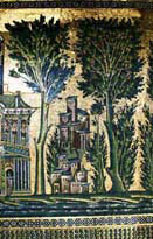The first Islamic dynasty, based in Damascus. The Umayyad caliphs ruled from 660 to 750 AD. The dynasty was founded by Mu’awiya Ibn Abi Sifyan, the governor of Syria under the Rightly Guided Caliphs.
The Umayyad caliphs were:
Mu’awiyah ibn Abi Sifyan, 661-680
Yazid ibn Muawiyah, 680-683
Muawiya ibn Yazid, 683-684
Marwan ibn Hakam, 684-685
Abd al-Malik ibn Marwan, 685-705
al-Walid ibn Abd al-Malik, 705-715
Suleiman ibn Abd al-Malik, 715-717
Umar ibn Abd al-Aziz, 717-720
Yazid ibn Abd al-Malik, 720-724
Hisham ibn Abd al-Malik, 724-743
al-Walid ibn Yazid , 743-744
Yazid ibn al-Walid, 744
Ibrahim ibn al-Walid, 744
Marwan ibn Muhammad (ruled from Harran in the Jazira) 744-750
The Muslim empire expaned greatly under the reign of the Umayyads. At its height it extended from the Atlantic coast of North Africa to the Indus valley. The administrative structures of the preceding Byzantines and Persians were left intact, but authority was consolidated to kinsmen of the caliph. Arabic became the official language and Islam the official religion of the empire. Before his death, Mu’awiya secured allegiance to his son, Yazid, thereby introducing dynastic succession to Muslim rule. The Umayyads were overthrown in the east by the Abbasid dynasty after their defeat in the Battle of the Zab in 750. The Umayyad dynasty ended with the assassination of all the family members except Abdul Rahman who fled to Spain and founded another Umayyad dynasty which ruled in Cordoba from 756 to 1031 AD.
The Umayyads built garrison towns such as Basra and Kufa, and cities on trade routes. They built fortress-like desert palaces in Syria, Jordan and Palestine where the elite went on hunting and gardening retreats. Some of the palaces were newly built; others were converted Roman or Byzantine forts. Some of the desert palaces remain today: Qusayr Amrah and Mshatta in Jordan, Qasr al-Hayr al-Gharbi and Qasr al-Hayr al-Sharqi in Syria, Khirbet al-Mafjar in Jericho, and Anjar in Lebanon. The palace layout contained halls, baths, residences, mosques, courtyards, stables and garden enclosures. They were lavishly decorated with floor mosaics, tiled walls and stucco carvings.
The Umayyad period is considered the formative period in Islamic art. Architecture and art were influenced by classical and Roman forms and by the styles of Mesopotamia and central Asia as artists continued to work in their established manner. In time new techniques, forms, and decorative conventions developed that distinguished this period and made it distinctly Islamic.
The oldest Umayyad mosque, the Dome of the Rock in Jerusalem was built by Abd al-Malik in 691. The Great Mosque in Damascus was built by the caliph al-Walid bin Abd al-Malik in 705. The Umayyads introduced the mihrab, the minaret and the dome to mosque architecture, and decorations such as mosaics, inscriptions, wall painting, frescoes, sculpture and carving.


